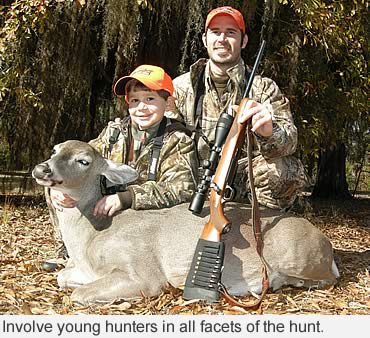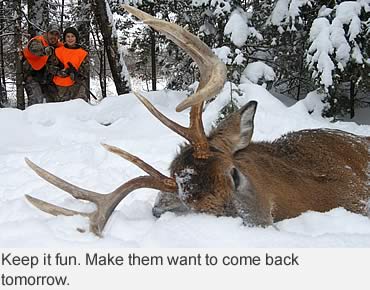Photo: Start young hunters small. Squirrel hunting is a perfect introduction.
In Kentucky, three experienced hunters and mentors—Captain Richard Adkins, Derek Beard and Mark Marraccini—have developed strategies for teaching hunting from their experiences of teaching their own children to hunt.
This fall, they’re sharing their experiences and offering some great tips for any hunter who wants to introduce a youngster to hunting,
Their home state of Kentucky offers youth hunters a number of special seasons. The same is true for most states. Take time to check into your state’s requirements and youth hunt dates.
Learning to hunt begins when a child begins the transition from observer to participant. It falls on an adult hunter’s shoulders to deliver a safe and enjoyable experience that will make their young companion want to return to the field another day.
To begin, a child should be confident in their ability to make a good shot when the opportunity presents itself.
Some Practice First
If an adult takes the child to a shooting range ahead of time, it establishes a comfort level and allows for repetition and instruction in a controlled environment.
“If you just want them to develop good, strong shooting fundamentals, you can do that with a pellet rifle or a .22 rifle, rather than hurrying them into a loud centerfire rifle,” advised Mark Marraccini, who is executive staff advisor for the Department of Fish and Wildlife Resources. “The fundamentals will transfer. The young shooter will not feel the recoil in a hunting situation, and he or she will barely remember the noise.”
 It’s important to stress safe handling of any firearm.
It’s important to stress safe handling of any firearm.
Richard Adkins, the training section supervisor for the Law Enforcement Division of Fish and Wildlife, wants his children to be as adept as possible with the firearm they will use in the field. To that end, he advises considering dummy rounds for practice.
“I want them familiar with that gun,” he said. “That way there’s no confusion.”
Start young hunters off small and work up. Squirrel hunting is the perfect introduction because it teaches woodsmanship and hunting skills that translate to larger game animals. Using a rimfire or small caliber rifle for squirrels will help hone a young hunter’s marksmanship.
Adult hunters should always take time with youngsters to review the rules and regulations before going afield.
Adjust for attention span and comfort
Kids have limited attention spans. Expecting a child to sit still for extended stretches of time is usually best done in a ground blind which allows for some freedom of movement and protection from the elements.
“I’m a firm believer in ground blinds for kids, and use ground blinds all the time,” Adkins explained. He also believes in setting up a stable hunting rest.
“I think it’s imperative they have some kind of mount to put the gun in so they can shoot accurately,” Adkins said. “It allows me to secure the gun so it’s like shooting off a bench. I’m a big proponent of them because they increase accuracy and increase safety. It was the best money I ever spent for them.”
Don’t forget snacks and drinks. Derek Beard and his children make it a tradition to stop at a gas station on the way to their hunt location.
 “They can buy anything they want, within reason,” said Beard, the Bluegrass Wildlife Region coordinator for Fish and Wildlife. “My oldest likes getting a Big Red soda and some Sour Patch kids, sunflower seeds and chips.”
“They can buy anything they want, within reason,” said Beard, the Bluegrass Wildlife Region coordinator for Fish and Wildlife. “My oldest likes getting a Big Red soda and some Sour Patch kids, sunflower seeds and chips.”
Make sure young hunters are dressed appropriately for the weather. Wet clothes, cold toes and icy fingers make for a miserable experience and end a hunt quickly.
“If their mittens have Snoopy on them, they’re probably not the right pair of gloves to wear on a hunt,” Marraccini said. “If their boots just keep their feet dry while they’re waiting for the school bus, they may not be the ones they need to wear when they’re sitting in a deer blind and it’s 30 degrees.”
Utilize technology
Kids love technology and it can serve a useful purpose when hunting.
After watching a YouTube video, Beard built an adapter that allows him to mount an iPhone to a riflescope. The larger screen makes it easier for his son to see through the scope. A video app allows them to record the hunt through the scope.
An iPad or similar device loaded with games or books can help kids pass the time in the ground blind.
“I can load games on it and he’ll play games for hours,” Beard said. “We can sit there and have competitions back and forth with the iPad. It keeps both of us entertained.”
What might be routine for an experienced hunter can captivate a young hunter. As a mentor, take time to point out how the woods come alive at daybreak. Identify sounds, animals, plants and trees. Explain why you’re hunting a particular spot.
“Those small things will go unnoticed sometimes, and then they become appreciated once they are pointed out,” Marraccini said.
If a parent or mentor involves a young hunter in all facets of the hunt, they’ll feel invested in the overall experience. Take them on your scouting trip. Run through the pre-hunt checklist with them. Let them help cook the chili back at the barn or camp because the social aspect of hunting can be just as much fun as the hunt itself.
Keep it fun. Every adult hunter wants to see a young hunter succeed and leave the field with a smile, but success can be measured in ways beyond whether an animal was harvested.
“Don’t overdo it,” Marraccini advises. “Make them want to come back tomorrow.”
--From: Kevin Kelly, Kentucky Afield, Kentucky Department of Fish and Wildlife Resources